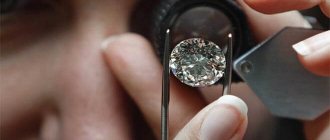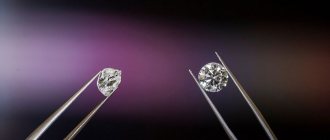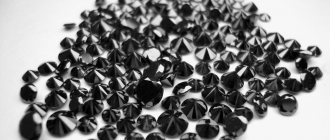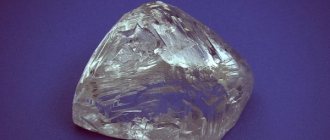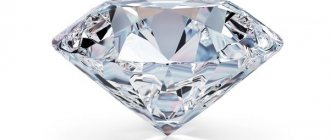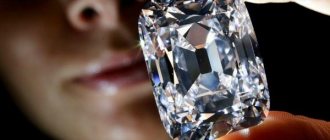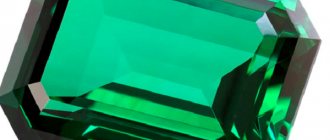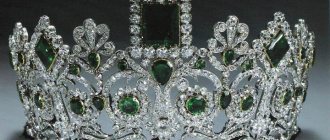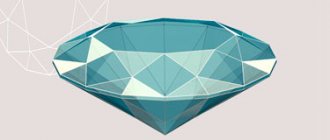As the name suggests, the cut (round, princess, radiant, etc.) describes the shape of the diamond, primarily as seen from above.
All cut shapes have their own parameters and characteristics, but in general, the beauty of a diamond’s shape is a matter of individual taste.
The brilliance and play of a diamond depend on the quality of polishing and cutting, the shape and proportions of the stone.
All of these are components of the final cost of the cut gemstone. A classic diamond is round in shape and has 57 facets. This shape allows the stone to reflect the vast majority of light. In addition, a stone of this shape boasts truly excellent play.
It is not surprising that diamonds of this shape are more common than others and are very expensive.
Rice. Yakut diamonds of various cut shapes
But round is not the only shape for diamonds. There are many varieties of cut shapes in the world. The so-called “fantasy” forms are very popular. Each of them, be it “marquise”, “heart”, “princess”, “pear”, “oval”, “emerald” or “baguette”, makes a unique impression, fitting perfectly into almost any jewelry composition.
Cut shape Circle
The classic round shape is renowned for its play and the greatest return of white to the person viewing the diamond. More than 3/4 of all diamonds sold are stones cut in accordance with this standard shape. There are 3 varieties of round shape, with 17, 57 and 85 edges.
Moreover, a smaller number of facets is inherent in the cutting of diamonds with the lowest weight, while large stones are processed into a shape with 85 facets.
Round Diamond Catalog
Catalog of rings with round diamonds
Types and classifications of cuts
There are situations when a jeweler comes across a diamond of an unusual shape. Then the fancy cut comes to the rescue
Common techniques:
- Stepped, in which the edges of the stone are parallel to the girdle and have a rectangular shape. Using this method, you can emphasize the purity of the stone.
- Modified - a fantasy option, which results in stones of different shapes.
- Mixed is the most popular technique after the round classical cut. People call her "Princess". It has a square shape with sharp corners and emphasizes the transparency of the stone and its shade. This stone looks like a pyramid. Since the lower part of the pavilion is quite massive, the entire play of light takes place there, which gives the mineral sophistication.
If we talk about the modified cut, it is popular due to its unusual shape, which is obtained in the end. With such products you can surprise others and express your individuality. These forms are also used in cases where it is necessary to display the purity of the stone as fully as possible.
Trilliant cut shape
A wedge cut with a triangular shape. There are several names for this shape: trillions, triangles or trillians. The shape and number of facets of these diamonds can vary significantly, but trillions have one thing in common - an invariably triangular shape.
Trilliates first appear in Amsterdam. This type of cut does not have any restrictions in terms of design - preference is given to the personal taste of the cutter and the natural parameters of the stone itself. The more traditional shape has sharp corners, but more rounded options are also possible.
Very often, trillions are found as side inserts in rings that have a larger stone. The width and length values should be as close as possible, only small deviations are allowed.
Trilliant diamond catalog
Trilliant diamond ring catalog
Fatal Diamond
Diamond Hope has a bad reputation. Its many owners were aristocrats and bankers. By a strange coincidence, they died, went bankrupt or went crazy. But the “curse of the stone” did not stop him from wanting to take possession of it. Unable to resist the magnetism of the blue crystal, people stole or repurchased it.
The path of the mysterious diamond is marked with a disastrous red thread. See for yourself:
- The jeweler Tavernier, who sold the stone to Louis XIV, was torn to pieces by dogs.
- The Sun King unexpectedly died from blood poisoning after cutting himself on a rusty nail while dancing.
- Queen Marie Antoinette, the next owner of the diamond, was executed by guillotine.
- Henry Hope died of a strange illness, his son was poisoned, and his grandson lost his fortune.
- Sultan Abdul Hamid II was deposed and imprisoned for the rest of his days.
- Evelyn McLean's husband went crazy, her son was killed by a car, and her daughter committed suicide.
- There is a version that the married couple, whose property was the ominous diamond, went on the Titanic on its last voyage, dying in its crash.
The tragic fate of the Titanic and the fatal diamond are combined in the story of James Cameron. Even the cut of the diamond in the shape of a heart is symbolically woven into the outline of the film. According to the director himself, he created the love story of Rose and Jack against the backdrop of the death of a huge liner so that through their emotions the viewer would open his heart to the full poignancy of this deeply sad tragic event.
And one more interesting detail: the blue color of diamonds is given by the presence of boron, which is found in the salt water of the seas. They are most often found on the site of former seas. At the end of the film, “The Heart of the Ocean” returns home...
Radiant cut shape
A wedge cut of a rectangular or square shape with an octagonal outline is the so-called radiant. All the best of the round diamond (play and spectacular brilliant cut) is combined here with the elegance of the emerald shape.
When cutting this shape, an increase in the weight of the gemstone is inevitable: in order to make the diamond play more intense, it is necessary to add depth to the pavilion. Radiant is the most common cut for large diamonds. This form also has the property of improving the color of fancy stones.
Radiant diamond catalog
Radiant diamond ring catalog
What is a diamond cut?
Cutting is the process of giving a shape to a diamond, which can highlight its noble color and remove natural defects, giving a glow to the gemstone.
Diamonds are cut by hand. This process is painstaking and thorough, and the quality of the cut and the further fate of the stone directly depend not only on the quality of the diamond, but also on the skill of the cutting specialist. The type, shape and cutting method of each crystal is selected depending on its size, weight, color characteristics and purity. The main objective of the diamond cutting process is to maintain its carat weight, and then to balance the clarity (presence of defects) and color of the diamond.
Diamond, step and mixed cuts
The diamond cut is a method of diamond processing in which the arrangement and number of facets give the stone maximum brilliance. This is a perfectly calibrated diamond shape, revealing its ability to reflect and refract light. For example, the classic round cut of a gemstone is a brilliant cut. Such a stone must have 57 facets.
A step cut is characterized by a strictly parallel arrangement of edges, which means the shape of the stone will be square or rectangular (very rarely, trapezoidal). This cut of the diamond does not add much brilliance or play of light, but favorably emphasizes the purity, transparency and depth of color of the stone. The most common step cut forms are emerald and baguette.
The mixed cut combines the features of both brilliant and step cuts. It is used when it is necessary to maintain the maximum weight of a gemstone, while emphasizing its color and quality characteristics. The most attractive and popular shape of this cut is the princess.
All non-classical round cut diamonds are called fancy. These include pear, heart, oval, marquise, cushion.
Circle
The circle cut has 57 facets (the generally accepted designation is Kr 57). This is perhaps the most popular diamond shape today.
It is designed specifically to maximize the shine of the stone. However, small defects and color tints in round diamonds will be less noticeable compared to stones of other shapes.
Many buyers prefer round diamonds, deservedly considering them classics.
Nowadays you can find round-cut diamonds with 17 facets (indicated on the product tag as Kr 17). In this way, small diamonds with a diameter of 0.7 to 1.2 mm are cut, which are attached as accompanying large or medium-sized diamonds, or in the form of diamond “sprinkling”, when the surface of the jewelry is as if strewn with small stones, as well as in diamond “paths” . The 17-facet circle cut allows you to maintain a balance between the brilliance and price of the diamond.
Princess
The princess cut is similar to the circle in light reflection properties, but this cut has the outline of a square.
A princess diamond sparkles a little less brightly than a round diamond, but this cut is a good option when looking for an elegant square-shaped gemstone with high brilliance.
Emerald and Asher
The emerald cut is a rectangular cut with truncated corners, and its square shape is called “Asscher cut”.
These two diamond shapes differ only in outline, and the number and arrangement of their faces are the same.
These cuts do not produce the same brilliance as the round or princess cut, but do show off the color and clarity of the diamond at its best.
Cushion
Diamonds with a rounded convex shape are called “cushion”. They can be square or rectangular, but their corners are always rounded, so the stone becomes cushion-like. The type of cut of such diamonds is called brilliant. Interestingly, a cushion diamond sparkles as brightly as possible in candlelight.
Radiant
The radiant cut is always a rectangular or square shape with slightly truncated corners. This cut is also a brilliant cut; it combines the best qualities of the “princess” and “emerald” shapes.
“Radiant” refers to a mixed type of cut and has high brilliance levels of the diamond, and also favorably emphasizes the shade of the gemstone. Fancy diamonds are cut in this form, which allows their color to be conveyed as brightly as possible. Such stones are very rare to find, and due to their strict shape, they are more often chosen by men.
Oval
Oval is another brilliant cut type that can be considered a modified version of the circle.
An oval cut diamond is a good choice for those who dream of stylish and original jewelry. An oval-cut gemstone will look especially impressive in a ring.
Marquis
Marquise cut diamonds are also oval in shape, but with two pointed ends.
This form is very original, but at the same time vulnerable to chips. Therefore, the sharp edges of the gemstone must be properly protected during the setting stage.
Pear
The pear cut is also an oval shape, but with one pointed end. This diamond is very similar to a drop or a pear.
The pear cut combines the features of the marquise and oval.
When choosing jewelry with a pear-shaped diamond, you need to make sure that its sharp end is well protected by the metal elements of the product.
Heart
The heart cut diamond is shaped like a pear, but the rounded side of the gemstone is shaped like a heart and has a small wedge.
When choosing jewelry with a heart diamond, pay attention to the symmetry of the stone, which is an indicator of the quality of this cut. Diamonds of this shape look best in jewelry such as pendants and engagement rings.
Baguette
The “baguette” cut refers to a stepped type of stone processing, and is more often found in the shape of a rectangle rather than a square. The sides of a rectangular baguette are in a ratio of 1.4 to 1. This is the simplest form of diamond cut and has the fewest facets compared to the others.
Such stones are transparent and look great in jewelry with a laconic design.
Emerald
mineral, gemstone of the beryl group. According to Fersman's classification, emerald, along with diamond, sapphire, ruby, chrysoberyl, alexandrite, noble spinel and euclase, is a first-order semiprecious stone.
The main criteria for the quality of an emerald are its color, and then its transparency. The ideal emerald is a transparent stone with an evenly distributed rich color. Large, defect-free emeralds of a dense tone weighing from 5 carats are valued more than diamonds.
We offer for sale emeralds from the Ural deposits (Malyshevskoye), as well as from Latin America.
The emeralds of Ural origin we offer have conclusions from the Assay Office of Russia and all relevant documentation.
Pear shaped diamond
In the 16th century, during the late Renaissance, two types of diamond cuts were popular: Rose and Briolette. The "Rose" was shaped like a round diamond, while the "Brillette" shape was similar to a tear or drop. Apparently, the Briolette was the forerunner of the modern teardrop-shaped diamond cut. The modern fifty-hex pear is a combination of a round diamond and a marquise diamond.
Diamond "Pear" fifty-hexagonal
Tear-shaped diamonds are often used in pendants and earrings due to their asymmetrical shape. “Pear” can also be an insert in a ring, because drop-shaped diamonds are slightly elongated, which means a woman’s hand decorated with a ring with a “Pear” diamond will look elegant and attractive.
Marquise diamond, shuttle-shaped
In the diamond collection of Cardinal Mazarin, who lived in the early Baroque era, there was a diamond weighing more than 15 carats, similar in shape to the modern “Marquise” - then such diamonds were called “Navette”, i.e. a shuttle or a small boat, and cut from elongated diamonds. The name of the Marquise diamond probably appeared only a century later thanks to the famous smile of the Marquise de Pompadour, a passionate lover of art and luxury, the favorite of King Louis XV. According to legend, the king wished to give the marquise a diamond shaped like her radiant smile. Therefore, in the 21st century, we can safely say that the Marquise diamond has become a traditional classic, although it was first presented to the public several decades ago.
Fifty-five-sided Marquis diamond
An elegant oblong-cut Marquise diamond looks spectacular surrounded by small diamonds that smooth out its wedge-shaped ends. The elongated shape of the Marquise diamond creates the effect of long and narrow lady fingers.
